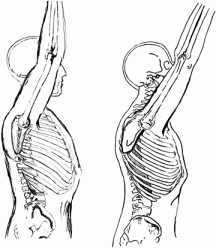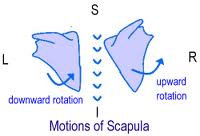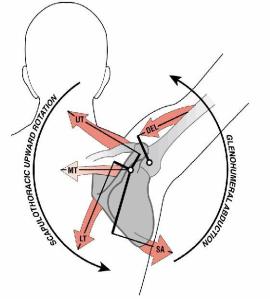Band resisted scaptions
The Problem:
Reaching (or pressing in strength training) over head is important to a wide variety of sports; however, many athletes, especially in bodybuilding, lack the shoulder ROM to fully extended the arm overhead such that the biceps and the ear align. Try it yourself, can you easily reach over head with a straight arm?
Achieving 180 degrees of shoulder flexion (i.e.: the military press lockout) is accomplished with 120 degrees of humeral abduction/flexion (via the deltoids) and 60 degrees of scapula upward rotation.
Deficiency in this movement is often the result of weakened scapula upward rotators, and in the case of many bodybuilders and power lifters, is due to under developed/activated lower trapezius and serratus anterior muscles. Fix it!
The Setup:
Unlock the knees and bend over at the hip. Keep the back and head neutral. Extend the elbows and raise upward and out to the side in a “Y” pattern leading with the thumbs. Drive the shoulder blades downward to achieve full a ROM – do not shrug the shoulders. Hold the position for a moment and slowly return to resting.
Once the athlete has become efficient at doing bent over scaptions, resistance can be added into the movement to improve lower trapezius strength (demonstrated below by Jason Cholewa). Either step on or attach light resistance bands to an immovable object beneath or behind the athlete. Slowly perform the movement, holding at the top of the ROM for moment. Emphasize depressing the shoulder blades to achieve a full ROM – do not shrug the shoulders.
Follow Jason Cholewa on Twitter



Jason,
I like the article. I noticed that when done bilaterally in your video the cervical spine goes into flexion. My buddy (a DPT) were playing around with these today and were finding that when done bilaterally it’s hard to not go into c-spine flexion, but this doesn’t occur when done unilaterally. What’s your thoughts?
*My buddy (a DPT) and I
Sorry just spent 5 hours doing patient notes.
That’s a good point, and I see the value in doing both unilateraly and bilateral. I think myself, especially after watching the video again, that I need to focus more on retracting my chin/head to engage the deep c-spine flexors and maintain a neutral spine. Sometimes when I focus on retraction it turns into c-spine flexion vs. neutrality.